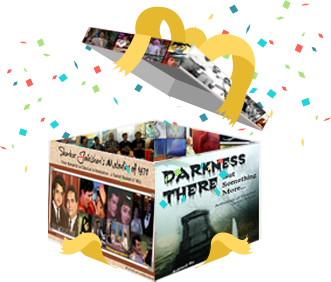
In the recently published book ‘Thank You Guru Dutt’, author Lata Jagtiani brings a fresh, nuanced perspective to understanding Guru Dutt’s artistic genius. Silhouette presents an excerpt of the book, as a tribute to the maverick filmmaker on his 100th birth anniversary.

Baazi poster
Date of release: June 15, 1951
Banner: Navketan
Producer: Dev Anand
Director: Guru Dutt (Assistants Raj Khosla and CM Nagotra)
Story: Guru Dutt and Balraj Sahni
Screenplay and Dialogues: Balraj Sahni
Director of Photography: V Ratra (Assistant VK Murthy)
Choreographer: Zohra Sehgal
Editor: YG Chawhan
Cast: Dev Anand, Geeta Bali, Kalpana Kartik, Roopa Varman, KN Singh, Johnny Walker, Rashid Khan, Krishan Dhawan and others
Music Director: SD Burman
Music Assistant: Suhrid Kar
Lyricist: Sahir Ludhianvi
Singers: Geeta Roy, Shamshad Begum, Kishore Kumar and the chorus
Songs: Total 8 songs, all solos. Geeta Roy (Dutt)-6, Kishore Kumar-1, Shamshad Begum-1, the chorus-2
1. Aaj ki raat piya—Geeta (Kalpana Kartik)
2. Dekh ke akeli mohe barkha sataaye—Geeta and chorus (Geeta Bali)
3. Laakh zamaane waale—Geeta (Kalpana Kartik)
4. Mere labon pe dekho—Kishore (Dev Anand)
5. Sharmaaye kaahe ghabraaye kaahe—Shamshad (Geeta Bali)
6. Suno gajar kya gaaye—Geeta and chorus (Geeta Bali and dancers)
7. Tadbeer se bigdi hui—Geeta (Geeta Bali)
8. Ye kaun aaya ke—Geeta Roy (Kalpana Kartik)
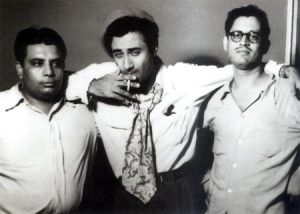
Dev Anand and Guru Dutt on the sets of Baazi (Pic courtesy: Rediff)
Like Alfred Hitchcock who used to be seen in his films for a few seconds, Guru Dutt makes his cameo appearance in the opening scene of the movie where he is shown seated by a roadside hydrant, with his back to the camera. He is seen smoking when an expensive car pulls up. We see his profile as he turns his face, and he seems puzzled to see a costly car stopping by in such a shady area. Suited and booted, the character actor Rashid Khan steps out of the back seat, carrying a walking stick. He advances purposefully towards Dutt, pauses to light a cigarette, then goes past him to descends a staircase. The camera turns around to watch the man go to the basement. No word has been said yet. That is how Dutt introduces suspense, from the very first scene! Again, in Jaal, Guru Dutt would make a cameo appearance as a fisherman, in a blink-and-miss kind of role. Deeply influenced by Western cinema, this ambitious young man wanted to leave his signature on his films until he began to act in them as the protagonist.
Released on June 15, 1951, the Navketan film Baazi premiered at Swastik Cinema on Lamington Road in South Mumbai. Baazi, in Urdu, means a gamble. At this time Guru Dutt was only 27 years old. The film was a success at the box office, it even celebrated its silver jubilee. Two of the main reasons for its success were the filming of the songs and the songs themselves.
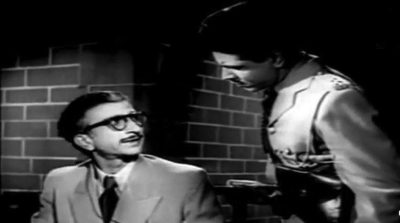
Raj Khosla and Krishna Dhawan in Baazi. Khosla had started his career as an assistant to Guru Dutt in this film.
Betting Big!
The film established many people’s careers and lives. Although was not Sahir’s first film, it was in this film that his work was first acclaimed. Nor was this Johnny Walker’s first film since he had been doing bit parts as an extra earlier too. It was during the breaks of the film Hulchul (released, like Baazi, in 1951, but much earlier) that Balraj Sahni had noticed how Johnny Walker, then an extra, would entertain the crew with his drunken act. Sahni introduced him to Guru Dutt and the rest is history. Johnny Walker said, “Baazi was the first film in which people noticed me. Before that whenever I’d take a friend to the cinema to see a film in which I had acted, I’d appear and then disappear before we knew what happened.” Similarly, Raj Khosla, who had always wanted to be a playback singer, was encouraged by Dev Anand to become an assistant director to Guru Dutt, after which there was no looking back for Khosla. In an interview Raj Khosla recalled, “Dev said to me, ‘Guru Dutt is going to direct my next picture, why don’t you become his assistant?’ So I met Guru Dutt!” Of course, Baazi was Guru Dutt’s first directorial effort too, and one knows how the success of this film changed his life.
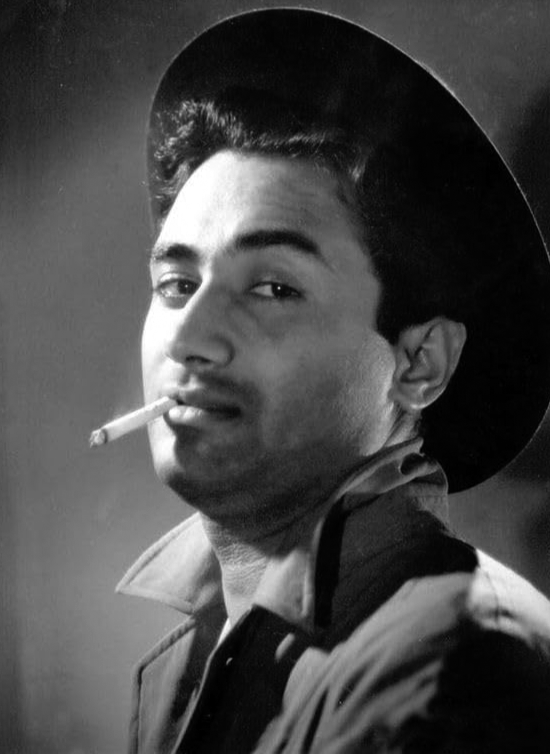
Dev Anand’s look in Baazi
The plot of Baazi centres on a risky gamble made by the protagonist played by Dev Anand. Behind the scenes, the film was a real-life gamble since two newcomers were placing bets on each other’s success. The risk taker that Dev Anand was, he handed over the director’s reins to Guru Dutt, who was still a fresher. Both of them were about to make a name for themselves.
Baazi also brought two beautiful and talented women into the lives of these two handsome bachelors. Geeta Roy who was already a singing sensation, was recording the song Tadbeer se bigdi hui taqdeer bana le when Guru Dutt walked in, saw and heard her for the first time, and instantly fell in love with her. Meanwhile, Kalpana Kartik was introduced in this film. Dev Anand, nursing his tears after his breakup with Suraiya, turned to Kalpana on the rebound.
The two couples later got married. So many life-changing bets were taken during the film whose subject was coincidentally, gambling Baazi was the turning point in their lives, both professionally and personally. All four fell in love, got married and had children.
Baazi set the trend for other similar Bombay noir crime thrillers. Some claim that the film was a copy of a Hollywood film called Gilda, which starred Rita Hayworth as the irresistible seductive woman, with Glenn Ford playing the part of the man who reciprocated her love. When I watched the film on YouTube, I was struck more by the differences between the two films than their similarities. Yet, as one moves forward through Guru Dutt’s cinema, one observes that both Bengali and Hollywood cinema played a significant role in providing Guru Dutt with the impetus and inspiration he desired.
The cinematography by V Ratra was adequately supported and assisted by VK Murthy. There were plenty of fascinating shots; some scenes, as with cinema noir, were intentionally in half-light and half-darkness. Most films of the time did not have close-ups, but this film had plenty.
Guru Dutt was quite nuanced in his presentations, and he employed symbols too. For example, a staircase would represent the descent of Man’s morality when he filmed villains descending a flight of stairs.
Guru Dutt was ahead of his time in quite a few ways. For one thing, in this film, he gave Geeta Bali top billing, above Dev Anand. Then, as a film director, he would have different endings for his films, and later decide which one to finally okay for the film. Originally, Dev Anand shared in his Filmfare interview, this film had two endings. One end had Dev Anand go to the gallows, and the other—the one that Guru Dutt finally chose—had the inspector slyly conning the villain into admitting his crime and making it easy for the hero.
Coming to this film, the plot is unusual: for one, here the nautch girl is the heroine, and the good girl is the supporting actress. While the nautch girl dies, the good girl pairs up with the crooked gambler who has changed and gone legit. The vamp dies in the end, protecting the hero, a convenient narrative ploy which has been used time and again to get the shady lady out of the lives of decent, socially acceptable members of society. After all, the director needed to pay attention to the audience and its tastes, because it meant box office returns!
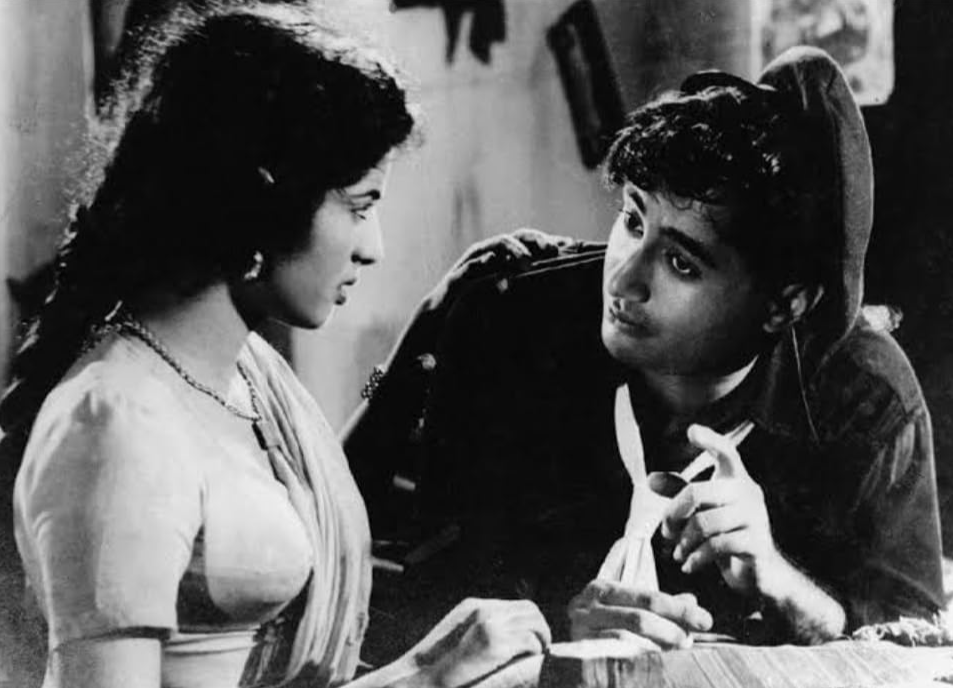
Kalpana and Dev Anand in Baazi (Pic: IMDb)
The SD Burman Songs!
The songs of this romantic thriller became extremely popular, with Geeta Roy winning hearts with six solos, which included three songs sung onscreen by Kalpana Kartik (Dr Rajani). They included Laakh zamaane waale, the romantic solo sung for an absent Dev Anand; Ye kaun aaya ke mere dil ki duniya mein bahaar aayi, sung in a situation which was later repeated in a few films, where the heroine sings for one man but another man believes she is singing for him. In this case, she was singing for Madan (Dev Anand) while it was Ramesh (Krishan Dhawan) who was deluded. Such a situation became a hit with audiences, inspiring other directors to use it for their later films. For example, fourteen years later in 1965, in BR Chopra’s Waqt, the song Kaun aaya ke nigaahon mein chamak jaag uthi, is sung by Sadhana for Sunil Dutt while Raj Kumar believes she is singing for him. Again this situation inspired Guru Dutt for his last film where he created a similar song Aap ke haseen rukh pe where Mala Sinha believes Dharmendra is wooing her but he is singing for her sister Tanuja! Coincidentally, in most of these songs, the triangular grand piano occupies centre stage as a symbol of the love triangle.
Aaj ki raat piya is a Geeta Roy seduction solo sung by Kalpana Kartik to a perplexed Dev Anand. Then there is Dekh ke akeli mohe barkha sataaye, with Geeta Roy lip-synching for Nina (Geeta Bali) in a club.
Aaj ki raat piya (Baazi, 1951) SD Burman/ Sahir / Geeta Dutt
The most popular song of the film belonged to Geeta Roy, which, despite being a ghazal, has been used as a club song. The solo, Tadbeer se bigdi hui taqdeer bana le, was also the film’s mahurat shot. It’s a seduction song sung onscreen by Geeta Bali in a club for Dev Anand, while she is playing a guitar. Dev Anand is shown attempting to go up the stairs (like the piano, the staircase was often a symbol in Guru Dutt’s films) but her song and beauty entices him down, both literally and figuratively. Dev Anand, in a chat with author Akshay Manwani, narrated how, when he was in Jodhpur and Baazi was in the cinema halls, the distributors of the film told Dev Anand that many Air Force pilots stationed there would come in time to the cinema-hall only to watch this song. Dev Anand recalled, “They would come only for this song, yeh popularity hoti hai!”
Biographer Nasreen Munni Kabir, in her biography of the genius, applauds Guru Dutt when she states that this song “…is another fine example of Guru Dutt’s instinct for using songs that not only hold attention for their own poetic and artistic merit but also to advance the story. The words of the song act as a catalyst for Madan. The struggle with his conscience is over and by the end of the scene, Madan has decided to throw the dice, gamble with his life and join the Star Club…Madan is very much a fifties screen hero, a loner unprotected by class or family, who is willing to bend moral codes to survive…the old view of right and wrong becomes blurred as Madan’s values are determined by an instinct for survival rather than by a belief in traditional norms.”
Tadbeer se bigdi hui (Baazi, 1951) SD Burman/ Sahir / Geeta Dutt
One of the non-Geeta solos is Dil ye kya cheez hai aur dil ki tamanna kya hai (Mere labon pe) where Kishore Kumar sings a flirtatious song for Dev. The other song is a Shamshad Begum solo, Sharmaaye kaahe ghabraaye kaahe, sung by a seductively dressed Geeta Bali, who is attempting to ensnare Dev Anand in a club. Interestingly, while both Kalpana Kartik and Geeta Bali lip-synch in Geeta Roy’s voice, Geeta Bali gets to sing a Shamshad Begum song too. A point worth noting here is that Geeta Bali lip-synched four songs, and Kalpana Kartik three, but Dev Anand lip-synched only one song.
The Cinematographer VK Murthy
The song Suno gajar kya gaaye, a Geeta Roy solo with a chorus, is most important when one studies Guru Dutt’s success. The dancers are in Arabian attire when the song starts with a giant bell in the background. It was in this scene that Guru Dutt noticed VK Murthy who was then the assistant of V. Ratra. Murthy, unlike Ratra, was a slim man. It is he who suggested to Dutt that the shot could be filmed through the mirror, moving to the scene where the women are dancing, to first show the dancers through the mirror and later glide away from the mirror, to show Dev Anand, with his back to the camera, slowly moving forward to take a seat near the performers.
In a video interview with Govind Nihalani, Murthy confided that they wanted to avoid showing Dev from the front because at that time he appeared slightly overweight; thus, it was important to shift the camera’s focus away from the front of his body. Since V Ratra was a heavy-built man, he could not manage to wriggle into the position required to film the shot the way Murthy wanted, so the skinny Murthy shot the scene himself. Once the scene was done, an impressed Guru Dutt offered him the job of Director of Photography for his next film. It is a breathtakingly innovative shot, on par with Hollywood’s best cinema. Geeta Bali is performing a snake dance, and her dancing companions also have snake-styled headgear. In the film, Geeta Bali loves Dev Anand so she is cleverly warning him, through the song, of the danger he could be in. This is one of those warning or chetavni (warning) songs that became identified with both Dev Anand and Guru Dutt.* She reminds him that time is of the essence and he should indulge himself, husn bhi faani aur ishq bhi faani hai, hans ke bita le do ghadi ki jawaani hai, samay guzarta jaaye. The dance is high in drama with villains preparing to draw out their guns and shoot. The excitement and suspense of the scene, in a very big way, contributed to the film’s success at the box office. And the success, in no small measure, belonged to Guru Dutt.
Suno gajar kya gaaye (Baazi, 1951) SD Burman/ Sahir / Geeta Dutt
The SD Burman biographer, HQ Chowdhury, perfectly described the musical team of Baazi when he observed, “The Baazi songs were scintillating and perfect to match India’s first ‘Film Noir’. Sahir wrote the ghazal Tadbeer se bigdi hui taqdeer bana le, which Dada (SD Burman) converted into a night-club song. An aghast Sahir protested. But that did not convince the stubborn Dada to change the tune; he never liked interference in his work. ” Chowdhury further added, “Geeta now came out of her melancholic from world to float freely in the world of Hindi film music. Dada thus converted his wailing Geeta into a lively, sensuous singer. A new chapter was opened for Geeta Roy, a new style of composition and singing.”
Incidentally, for SD Burman, the year 1951 was a windfall year. He had six films with many hit songs. Chowdhury offers us an interesting bit of info, “The year saw Dada with his first car. Dada’s first car was a black Austin A 40.” All eight of them, Dev Anand, Guru Dutt, SD Burman, Sahir Ludhianvi, Geeta Bali, Kalpana Kartik, VK Murthy, and Johnny Walker, were riding on the wave of the success that this film brought them.
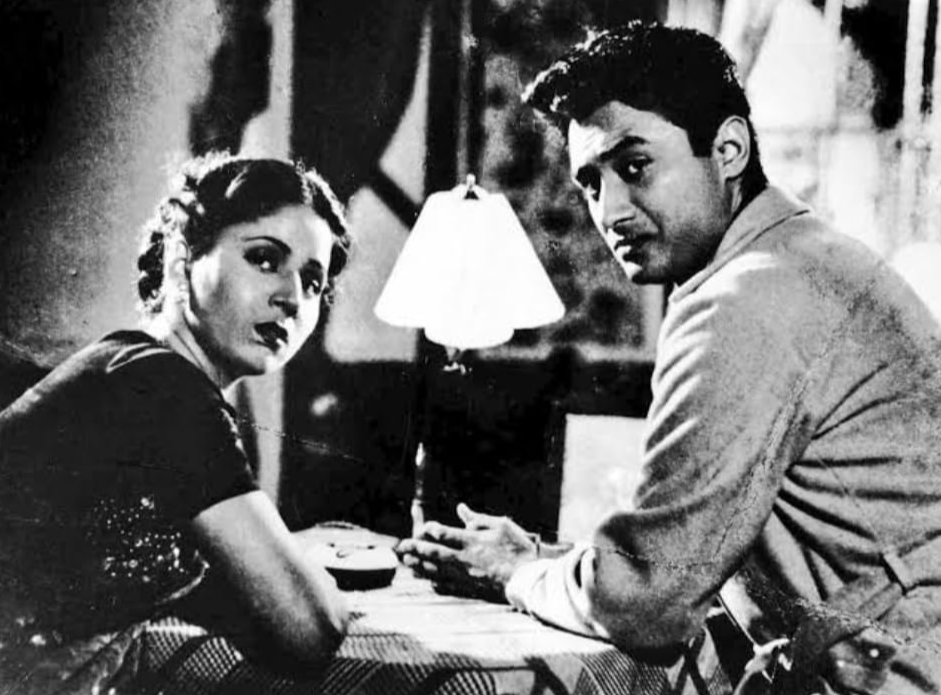
Geeta Bali and Dev Anand in Baazi (Pic: IMDb)
Dev Anand summed up Baazi perfectly when he wrote in his autobiography, “A hit film is like the Almighty’s blessings to all those associated with it. Overnight, Guru Dutt started riding a big horse. My position further stabilised and Dada created a niche for himself in film music spelling magic amongst moviegoers.”
Meanwhile, what did the critics make of it? Here is the irrepressible Baburao Patel, in the August 1951 issue of Filmindia in his critique of Baazi: “Baazi has quite a few beautiful bits in songs and dances, several excellent passages in the dialogue and a beautiful performance by that inimitable artiste Geeta Bali. And if you can forget the unholy mess the director and those two new girls (Roopa Varman and Kalpana Kartik) make, Baazi may be seen for its beautiful bits.”
Be that as it may, the audience loved the film and its direction, and gave the makers the much-coveted box office returns. Patel could not deter the audience which, quite simply, couldn’t get enough of this movie!
*There is a separate chapter on such songs in the book.
Excerpted with permission from ‘Thank You, Guru Dutt’ by Lata Jagtiani, published by Notion Press in 2024.
Book Title: Thank You, Guru Dutt
Author: Lata Jagtiani
Published by: Notion Press
ISBN: 979-8896103141
Pages: 428
Available on: Amazon
Note about the book
By Antara
‘Thank You Guru Dutt’ is a profound cinematic exploration that delves deep into the intricate world of one of Indian cinema’s most enigmatic auteurs. Moving beyond mere chronological recounting, ‘Thank You Guru Dutt’ meticulously dissects and analyses Guru Dutt’s filmography with remarkable depth and insight.
Lata Jagtiani brings a fresh, nuanced perspective to understanding Guru Dutt’s artistic genius. She expertly navigates through the filmmaker’s creative process, examining everything from his innovative technical approaches to his passionate pursuit of perfection, from his complex relationships to his groundbreaking musical and visual techniques. You rediscover the cinema you love with new perspectives and marvel at how Guru Dutt could convey a feeling, an emotion or a thought with just a frame, a symbol or a camera angle.
What sets this work apart is its holistic portrayal—balancing professional achievements with personal vulnerabilities. For cinema enthusiasts like me and scholars alike, it is a journey into the mind of a true cinematic maestro.
More than a conventional biography, ‘Thank You Guru Dutt’ is a celebration of artistic brilliance—a testament to a filmmaker who transformed Indian cinema, leaving an indelible mark despite his abbreviated career.
More Must Read in Silhouette
Early Films, and Raj Kapoor’s Best—with Nargis
Director’s Chair, ‘Sui Generis’: A Book in a Class of Its Own
Yeh Un Dinoñ Ki Baat Hai – In Conversation with Yasir Abbasi
Guide, The Film: Perspectives – A Very Well-Crafted Treasure of a Book
Whether you are new or veteran, you are important. Please contribute with your articles on cinema, we are looking forward for an association. Send your writings to amitava@silhouette-magazine.com
Silhouette Magazine publishes articles, reviews, critiques and interviews and other cinema-related works, artworks, photographs and other publishable material contributed by writers and critics as a friendly gesture. The opinions shared by the writers and critics are their personal opinion and does not reflect the opinion of Silhouette Magazine. Images on Silhouette Magazine are posted for the sole purpose of academic interest and to illuminate the text. The images and screen shots are the copyright of their original owners. Silhouette Magazine strives to provide attribution wherever possible. Images used in the posts have been procured from the contributors themselves, public forums, social networking sites, publicity releases, YouTube, Pixabay and Creative Commons. Please inform us if any of the images used here are copyrighted, we will pull those images down.